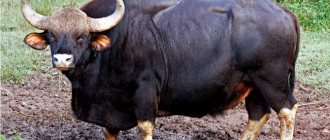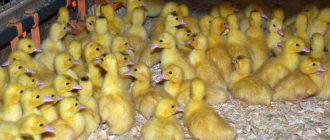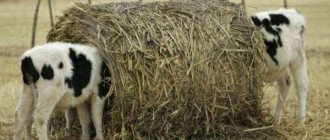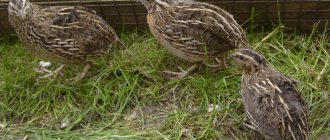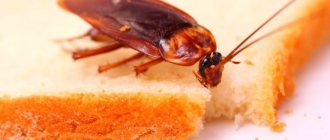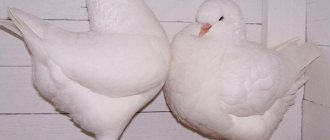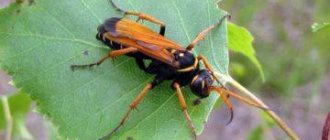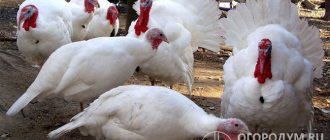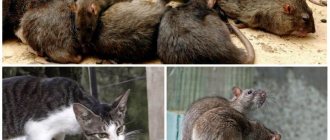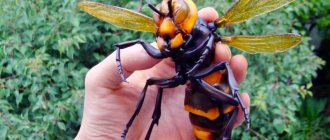There are significantly fewer breeds of turkeys than any other poultry. There are only 31. Half of them are bred in Europe. Raising turkeys for meat has become a very profitable business. Because on average a male weighs about 20 kg, and a female a little less than 10–13 kg. And this is at relatively low maintenance and feeding costs. In addition, turkeys still lay eggs and have good maternal qualities. Despite the fact that for another month they will lead the chicks with them, sheltering them from the cold. Turkeys have plumage of different colors and are characterized by good productive performance. Therefore, when choosing a breed or cross for backyard breeding, you need to familiarize yourself with the main characteristics in advance and select the one you need. Typically, farmers choose those breeds that can quickly gain a lot of weight in a short period of time. We will tell you in this article which crosses are the largest and which are the most egg-laying or hardy.
Largest turkey: Canadian
Everyone knows that turkeys are the largest poultry. But among them there are record holders for weight. This is, for example, a Canadian turkey. It belongs to the broiler type and is the result of the work of Canadian breeders. This poultry has a unique and characteristic exterior:
The Canadian breed quickly gains weight.
After three months it reaches slaughter weight. Long and massive legs;- The chin is in the form of a fleshy appendage;
- The plumage is black or white. May have a bronze tint;
- The body is dense, elongated. The chest is powerful, fleshy;
- They are unpretentious in food and by one and a half months of life they can already weigh about 5 kilograms;
- Marketable weight is gained by three months;
- They begin to lay eggs at nine months;
- The percentage of eggs hatching is very high.
Fattening this cross is profitable until the age of 90 days, then the bird goes to slaughter.
Characteristics: how much does it weigh
Main productivity indicators of Canadian turkeys:
| Indicators | Units | Productivity |
| Turkey live weight | kg | up to 30 |
| Turkey live weight | kg | until 17 |
| Egg production | things | about 100 |
| Egg weight | gram | from 70 to 80 |
| Laying period | months | from 9 to 15 |
| Egg hatchability | % | 93 |
Cross Butte 8
The Bute 8 cross breed is also a product of British United Turkeys. It belongs to the heavy and medium-sized type of turkey meat breeds. Adult males weigh 25-27 kg, females weigh 10 kg on average. Birds mature over a period of 5 months.
The plumage of birds is white throughout the body, without colored patches. The head and neck are gracefully curved, the beard is red. The breed is not very common in domestic poultry farming.
The best breeds for meat
Each breed of turkey has its own methods of keeping, breeding and preparing a diet. Birds are usually divided into three groups:
Lungs. Turkeys of this group have a relatively small weight. Males - 10–12 kg, females about 5 kg. The advantages of these birds are:
- Good egg production;
- Endurance;
- Disease resistance.
Pedigree representatives of birds are turkeys of the Victoria breed, Tikhoretsk black, white Dutch, Norfolk black, small Beltsville.
Average. The weight of adult males is 15–16 kg. Females - about 7 kg. Birds of this group are meat-type breeds. Representatives: North Caucasian bronze, North Caucasian black, Moscow white, fawn, etc.
Heavy. This group includes large and very large meat breed turkeys. The weight of an adult turkey can reach 30 kg. The weight of the turkey is more than 12 kg. Representatives of broiler breeds are white broad-breasted, Canadian broad-breasted broiler, BIG 6 cross and some others.
Heavy meat cross BIG 6
Cross BIG 6 is a common breed of turkey, which is popular not only in the post-Soviet countries, but throughout the world. After turkeys of this cross, many more productive breeds were bred, but BIG 6 remains just as popular and widespread. This breed is the result of crossing BIG 5 males and BUT 8 females. English breeders ensured that the cross received the following advantages:
- Precocity;
- Good immunity;
- Improved chick survival and viability.
By the seventeenth week of life, the bird has gained sufficient weight for slaughter. The weight of a turkey by that time is 15–17 kg, and that of a turkey is about 10 kg. Pure meat of the total weight is 78–80 percent. Read also about breeding turkeys of the Grade Maker breed in this article.
Hybrid Converter
Hybrid Hybrid Converter is gaining more and more popularity and birds of this breed can often be seen in private backyards in Russia and post-Soviet countries. Many farms are successfully breeding this cross due to the many positive characteristics inherent in it:
Hybrid Converter have strong muscles, white plumage, and a bright red beak.Large muscle mass;
- High quality meat;
- Precocity;
- Attractive presentation;
- Unpretentiousness and relatively low feed costs.
The males of this hybrid are larger than the females and have a fan-like tail. The weight of an adult turkey is 20–25 kg, a turkey is 10–12 kg. Hybrid Converter do not have high egg laying rates. During the season it can be only 50–80 pieces. Under good conditions and a balanced diet, the number of eggs laid by the female increases to 150 eggs. This breed is a meat breed and this is the main purpose of its breeding. Hybrid Hybrid Converter can be grown in almost any region. Turkeys have a strong immune system, very rarely get sick, and are unpretentious to climate conditions.
You can find out how many days a turkey sits on eggs here.
In order for a bird to develop as quickly as possible, it is necessary to create comfortable living conditions for it, select high-quality food and balance the diet.
Breeding, conditions of detention
During industrial breeding in large farms or poultry farms, the number of livestock is increased by incubating eggs. For small private farmsteads, it is preferable to purchase young stock from trusted suppliers.
To select healthy individuals when purchasing, follow the following rules:
- The chick's plumage should be smooth and even, its navel dry, and its tummy soft.
- It is important to make sure that the wings fit snugly to the body.
- A healthy turkey chick moves actively and is stable when moving.
- Reaction to voices, other sounds and noise should be quick.
After purchasing or hatching in an incubator, the chicks are immediately placed in an insulated place, where the temperature is maintained at 31 to 34 ℃ until they are a week old. By the end of the 2nd week it is gradually reduced to 24-27 ℃. Month-old turkey poults are comfortable at 18-20 ℃.
The babies are placed in a brooder or cage made of fine mesh, the height of which should be about 0.5 m. Cardboard or thick paper is placed on the mesh floor, which is regularly changed when dirty.
At first, the chicks are provided with round-the-clock lighting; by the 6th week, the lighting period is gradually reduced to 8-12 hours.
For further maintenance of young animals, a special room is equipped in which the air temperature is maintained from 17 to 20 ℃ and humidity within 60-70%. The poultry house is equipped with forced ventilation and opening windows to ensure constant ventilation and fresh air flow. In this case, windows should be opened only in calm weather to avoid drafts.
The size of the poultry house is determined at the rate of 1 m2 per individual.
Once they reach 5 weeks of age, males and females must be raised separately. To do this, the room is divided with a fine mesh into compartments, the area of which corresponds to the number of heads. At a height of 0.8 m from the floor, several perches are installed, made of strong beams (7-8 cm in cross-section), located at a distance of 0.6 m from each other. Drinkers and feeders are installed in each compartment. Suitable drinking bowls to protect the bird from getting its feathers and paws wet should be shallow and located at neck level.
It is recommended to install turkey feeders at a height of about 15 cm
Birds need an open pen for walking. It is recommended to sow it with grasses, for example, alfalfa, clover, peas. It is also important to prepare a place with sand or a special ash bath (a trough or box with a mixture of sand and ash) in the walking yard to clean the feathers and skin of dirt and parasites. The territory must be securely fenced, since from time to time Hybrid Converter turkeys exhibit unmotivated outbursts of aggression. For ease of maintenance, the poultry house is connected to the aviary with additional manholes and hatches.
What kind of unpretentious ones are there?
Compared to chickens, turkeys are quite fastidious birds, but there are still breeds that are less demanding on climatic conditions and feed. Perhaps a novice poultry farmer who has decided to have turkeys should practice on chickens, because breeding and keeping them are a little similar. But if you still decide to start breeding turkeys, you need to know which breeds are less capricious so that the business you have started will be crowned with success.
Black Tikhoretskaya
Belongs to the lung group. The breed got its name because the color of the birds' plumage is black. Turkeys of this species also have the following common characteristics:
They got their name due to the color of their plumage - it is black, glitters in the sun, and the tail also has a bronze tint.Strong muscles and slightly elongated body;
- Small head, wide beak;
- The plumage is shiny, iridescent, black;
- Tail part of bronze shades;
- from the neck .
The weight of an adult turkey can reach 10 kg, females up to 5. In some cases, these figures can be slightly higher. The male is much larger in size, almost twice as large. The Tikhoretsk breed has the following positive qualities:
- Resistance to stressful situations;
- Calm disposition, trusting. They can be safely released into open areas for walking, since the birds are adapted to pasture conditions;
- Turkeys have a well-developed maternal instinct.
The amount of meat from the total body weight of this breed is about 60 percent. Poultry can be slaughtered from 17 weeks of life. By then she gains weight up to 3 kg. However, experienced farmers recommend waiting a little so that the young animals have time to gain more weight.
The Tikhoretsk turkey can lay more than 80 eggs per season, so this breed can be bred not only for the purpose of producing meat.
Kubanskaya
The weight of an adult male is around ten kilograms, females are about five.
The birthplace of this breed is the Krasnodar region. To breed Kuban turkeys, breeders needed to do serious work. And the result was not long in coming. The Kuban breed of turkeys is unpretentious in keeping and adapts well to almost any climatic conditions. The bird is quite active, so for its breeding it is advisable to designate an area for walking. Turkeys of this breed have good immunity, which resists many diseases. With proper maintenance, the mortality rate of young animals is low. With a properly balanced diet and comfortable housing conditions for the bird, a turkey is capable of laying more than 100 eggs per year.
The survival rate of chicks to adulthood is ninety percent, which is a relatively high figure. You can find out how to care for turkey poults here.
Kuban turkeys tolerate low temperatures well, so they can be grown in different climatic zones. When feeding, they do not require any special diet, so maintenance costs will not be high.
French, weight 12-13 kg
Turkeys of this breed have beautiful feathers and relatively small sizes. By the 4th month of life, the bird reaches its maximum weight and can be slaughtered for meat. The survival rate of turkey poults is about 75–90 percent to adulthood. This fairly high viability rate is due to the bird’s good immunity. The weight of adult individuals reaches 12-13 kg. The French breed of turkeys is unpretentious to food and does not require the inclusion of expensive feed additives in the diet.
Birds of the French breed are active and mobile, therefore, when planning a poultry house, it is advisable to allocate an area for them to walk in open space.
Feeding
The most important features of feeding heavy crosses:
- The basis of the diet is protein foods.
- The presence of mineral and vitamin supplements in the feed.
For the first 3 weeks, turkey poults require 7 meals a day, then gradually the number of feedings is reduced and by the age of one month the babies are transferred to eating 4 times a day.
The chicks' diet requires: cottage cheese, chopped eggs, steamed grains of buckwheat, corn, wheat, to which it is recommended to add special feed for broiler turkeys PK5 and PK6. The introduction of crushed eggshells, chalk and bone meal into the mash will help accelerate the growth of livestock, strengthen the musculoskeletal system and increase immunity.
With proper care and a well-balanced diet, turkey poults show rapid weight gain
The diet of adults is based on porridges made from wheat, corn, oats, and other grains, which are also recommended to be alternated with feed for broilers. In addition, boiled potatoes, beets, carrots and other seasonal vegetables should be added to the mash. Vitamin supplements and microelements should be present in the diet of birds all year round. Valuable protein is found in large quantities in fish and meat scraps.
Fresh greens are necessary for both children and adults - they happily eat the leaves and stems of nettles, dandelions, peas, and alfalfa. For the winter, hay is prepared from grass, which is crushed and soaked before feeding.
Approximate norms of weight gain and feed conversion indicators that can be used as a guide when raising young animals are given in the table:
| Age (weeks) | Weight, kg) | Feed consumption (males) | Feed consumption (females) | Conversion | |||
| male | female | per week | total | per week | total | males/females | |
| 1 | 0,17 | 0,17 | 0,17 | 0,17 | 0,17 | 0,17 | 1/1 |
| 4 | 1,34 | 1,15 | 0,76 | 1,64 | 0,67 | 1,53 | 1,22/1,33 |
| 8 | 5,1 | 4,27 | 1,81 | 7,25 | 1,69 | 6,77 | 1,42/1,59 |
| 12 | 10,42 | 8,23 | 3,06 | 17,81 | 2,38 | 15,39 | 1,71/1,87 |
| 16 | 16,47 | 11,42 | 4,27 | 33,1 | 2,64 | 25,57 | 2,01/2,24 |
| 20 | 21,7 | 12,57 | 5,22 | 52,72 | 2,75 | 31,01 | 2,43/2,47 |
| 22 | 23,94 | 12,57 | 5,62 | 63,82 | 2,75 | 31,01 | 2,67/2,47 |
A turkey weighs more than 20 kg by the age of 5 months, a turkey weighs up to 13 kg
The best hens
The egg production rates of turkeys are not as high as those of some breeds of laying hens, but the eggs are large and tasty. In addition, the majority of turkeys have a well-developed maternal instinct, they incubate eggs and are able to breed healthy offspring. Such positive characteristics of some breeds are good because an incubator is not needed to hatch and breed young animals. This is a significant saving of money that would have to be spent on the device itself, and electricity bills will be lower. For raising turkeys in small quantities on private farmsteads, purchasing an incubator is not practical.
White Moscow (Russia)
A female White Moscow breed can lay 80–110 eggs over the course of a year.
White Moscow turkeys were bred in Russia. The main tasks that the breeders set for themselves before breeding this breed were to obtain meat specimens and increase egg production rates. The White Moscow belongs to the middle group of turkey breeds. The weight of an adult male can reach up to 16 kg, females – up to 8 kg. By 5–6 months of age, the bird gains weight of about 4 kg.
General signs:
- The feathers are white with a black spot in the chest area. Males, unlike females, are larger in size and have longer plumage on the neck;
- The body is medium in size, long lower limbs, the pink beak is slightly curved.
Turkeys of this species are very hardy and unpretentious to climatic conditions, so they are often bred by both farms and poultry farmers in private backyards.
Bronze large broad-chested
The basis for obtaining the bronze broad-breasted was wild turkeys and the English black breed. Main exterior characteristics of the bird:
This breed of turkeys has strong immunity, is hardy and resistant to many diseases.Wide chest;
- Dark color of the feather cover, iridescent with bronze-green shades;
- The color of the tail is small brownish stripes with a black and white trim at the top of the feather. Turkeys usually have a white patch on their chest;
- The weight of an adult turkey is about 16 kg, females up to 10 kg.
In a year, a turkey can lay 100-120 eggs, eighty percent of which are fertilized. Females have a well-developed maternal instinct, and they often incubate their offspring themselves.
The Bronze Broadbreast is not well suited for grazing in open spaces. Therefore, industrial conditions are more suitable for its breeding.
This material will tell you how to build a turkey poultry house.
Breed Station wagon
Cross station wagon is a breed of turkey that is characterized by high rates of weight gain. The weight of an adult male reaches 17 kg, and sometimes a little more. Females are somewhat smaller and have a body weight of up to 10 kg. The station wagon cross is suitable for breeding in private backyards and is widespread not only in Russia, but also in other countries.
Turkeys in the eighth week of life gain weight up to seven kilograms. General characteristics of a station wagon cross:
- White color of feathers;
- Strong body, powerful wings and long legs;
- Good survival rate of chicks (reaches 99 percent), and excellent vitality of growing individuals;
- Strong immune system;
- Females lay 60–70 eggs per year;
- The fertilization rate of eggs is 80–90 percent, which is quite a high figure.
Chiton turkey
This breed was developed in the Netherlands. The bird's feathers are predominantly white. The weight of an adult male can reach 18–20 kg. The weight of females is approximately 12–15 kg. The bird gains its maximum weight by 30 weeks of life. Over the course of a year, a turkey can lay 90–110 eggs. Adult males, in good housing conditions and with proper feeding, can reach a weight of 20 kg or even more. Females are slightly smaller, but still not very far behind turkeys. The weight of an adult turkey is up to 16 kg. Chiton has good egg production. During the season, a turkey can lay 100 eggs.
Breeding this breed does not require much effort or the use of special diets and expensive feed.
White broad-breasted
The category of the largest breeds includes white broad-breasted turkeys. They were bred in America in the middle of the 20th century. The White Dutch and Bronze Broad-breasted breeds were used in the selection. Received 3 lines, differing in weight:
- light – the weight of females/males is 5 and 9 kg, respectively;
- average – 7 and 17 kg;
- heavy – 10-11 kg and 23-26 kg (males’ weight at 6 months – 11-15 kg).
After six months, growth rates slow down, so it is recommended to release young animals for slaughter at the age of 100-180 days.
The bird's body is oval, with well-developed muscles. Legs are strong, widely set. The plumage is dense, glossy, white. There is a black feather (“medallion”) on the chest. Egg productivity – 100-120 pcs. weighing 80-90 g.
Pros:
- good adaptation to different weather conditions;
- universal productivity;
- precocity;
- calm character (except for the breeding season).
Minuses:
- tendency to heart disease;
- obesity (due to improper fattening).
conclusions
When breeding any poultry, you want to get a good result, because a lot of energy and money are invested in buying and raising it. Many poultry farmers have switched to raising turkeys. Because they are able to gain a lot of mass in a very short time. In addition, turkeys have good egg production and are also good and caring mothers. There are a little more than 30 breeds and crosses, so there is plenty to choose from:
- Meat giant crosses. Representatives of broiler breeds are white broad-breasted, Canadian broad-breasted broiler, BIG 6 cross and some others.
- Undemanding in terms of feeding and maintenance. Tikhoretsk black, Kuban, French and other breeds.
- Good hens. White Moscow, bronze broad-chested, chiton and others.
- In any case, by choosing the option you need, by the end of the breeding season you can get a lot of dietary meat and eggs for reproducing replacement young stock.
The pros and cons of raising turkeys as a business, read this link.
Who is he - the biggest turkey?
To this day, the largest domestic turkey remains a representative of the white broad-breasted breed. A huge male named Tyson weighed about thirty-nine kilograms. This giant grew up on the British farm Linkforth, which is located in Cambridgeshire, UK.
In size, it was significantly superior to its fellows, for which it was awarded the honor of being called “The Largest Domestic Turkey in the World.” According to his owner, an English farmer, no additives or bait were used when growing Tyson.
The turkey chick received only natural protein mixtures, grains and vitamins, thanks to this daily menu this famous male gained his record weight. The main thing, according to the English farmer, is to pay attention to the nutrition and living conditions of the birds.
About
How to achieve weight gain?
It is quite logical that when keeping broiler breeds of turkeys, which is what a hybrid converter actually is, a farmer needs to have minimal knowledge about products that contribute to rapid weight gain.
Adults need to be fed completely differently from turkey poults. At first, the diet for chicks should include dairy products and steamed porridge. It is very useful to give chopped boiled eggs to turkey poults to quickly gain weight and accelerate their growth rate.
The farmer should know that for the development of the chick it is very important to receive the necessary microelements and vitamins on time. For these purposes, it is worth stocking up on vitamin complexes, as well as giving the bird antibiotics to prevent respiratory diseases.
At first, a table of daily calorie content that he can compile himself may be convenient for a farmer. Gradually, as the chick grows, the daily calorie intake should be increased.
As the bird grows older, its diet should be varied. The volume of daily feed for broiler breeds is calculated according to the rule: for one kilogram of bird weight there should be one and a half kilograms of finished feed.
Various cereals and vegetables can serve as a daily source of nutrition for Hybrid Converter turkeys. They gain weight well from starchy corn varieties. You can also give adult birds oats and barley grain.
Often, farmers feed broiler varieties of birds with commercial feed. Such nutrition should definitely be alternated with the intake of greens and herbs. It is necessary to feed in the summer with green onion shoots, young nettles, and dandelion leaves.
Thus, the bird will receive the missing vitamins. In winter, when greens are in short supply, turkeys should be given vitamin complexes and water-soluble minerals. In winter, they feed with coniferous branches, which contain a huge amount of nutrients and improve the digestion of turkeys. Also, do not forget that birds should have access to drinking bowls with clean drinking water.
The largest turkey: which breed is the largest and which is best to breed at home
There are significantly fewer breeds of turkeys than any other poultry. There are only 31. Half of them are bred in Europe. Raising turkeys for meat has become a very profitable business. Because on average a male weighs about 20 kg, and a female a little less than 10–13 kg. And this is at relatively low maintenance and feeding costs. In addition, turkeys still lay eggs and have good maternal qualities. Despite the fact that for another month they will lead the chicks with them, sheltering them from the cold. Turkeys have plumage of different colors and are characterized by good productive performance. Therefore, when choosing a breed or cross for backyard breeding, you need to familiarize yourself with the main characteristics in advance and select the one you need. Typically, farmers choose those breeds that can quickly gain a lot of weight in a short period of time. We will tell you in this article which crosses are the largest and which are the most egg-laying or hardy.
Care
Turkeys are very sensitive to weather conditions and housing. Therefore, caring for them must be especially careful.
Elimination of drafts in the room and maintaining a constant temperature regime not lower than +10˚С in winter and +20˚С in summer. Regular ventilation, since dampness and musty air are the main sources of the spread of diseases. A thick bedding of straw or sawdust is changed several times a week with free maintenance; in cellular conditions an additional tray is installed.
In an outdoor enclosure, in cold weather, straw mixed with food is scattered over the snow. Thus, the livestock is forced to move and walk.
In addition to a container with ash to remove parasites, they construct a bath with chalk and crushed shell rock.
Grade Maker
Grade Maker turkeys were bred in Canada. The breed is aimed at obtaining maximum profit from the sale of large quantities of meat. Birds are considered early maturing and are ready for slaughter at 2-3 months. Grade Maker is characterized by very tender, tasty fillet and attractive presentation. To obtain a large yield of high-quality products, turkeys do not require a special type of nutrition or intensive care.
Grade Maker has a strong immune system that can resist many avian diseases. This fact makes the breed even more interesting and significant for poultry farmers. Turkey only has temperature requirements. Grade Maker feels comfortable at 24 degrees Celsius indoors. Birds reach their maximum weight at five months and are ready for slaughter. Further fattening does not make sense. The weight of an adult Grade Maker is twenty kilograms.
Moscow bronze
A breed of turkeys of Russian origin, distinguished by the beauty of their colors and endurance, is called the Moscow Bronze. It is suitable for growing in poultry farms and private backyards. The bird adapts to both pasture conditions and closed cages.
One female produces 80-90 eggs per year. The size of the birds is average, the male reaches 19 kg, the female – 9-10 kg. The slaughter age begins at 4-5 months. A characteristic feature of the breed is the beautiful plumage of birds. The feathers are black, brown and white with a pearlescent tint. The birds' wings are decorated with bronze-white stripes. The chest is wide, the body is elongated. The head is white, the beard is red. The skin color of birds of this breed is dark, which reduces the presentation of the carcasses.
Fawn
The breed belongs to the mixed egg-meat type. It was developed in Uzbekistan. The fawn turkey is adapted for life in southern latitudes and is widespread in the Caucasus and Central Asia. The size of the birds is average, males reach a weight of 12 kg, females - 6-7 kg.
The feather color of the breed is always red, ranging from light brown to beige. The bird grows slowly and gains weight. Feels better when free-range. Egg production is up to 60 pieces per year. The survival rate of chicks is low, no more than 65%.
